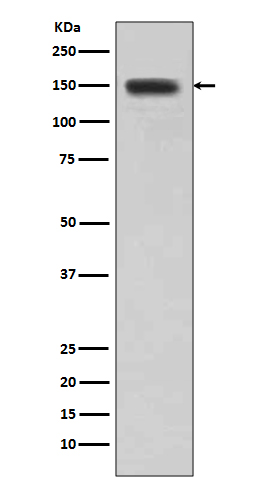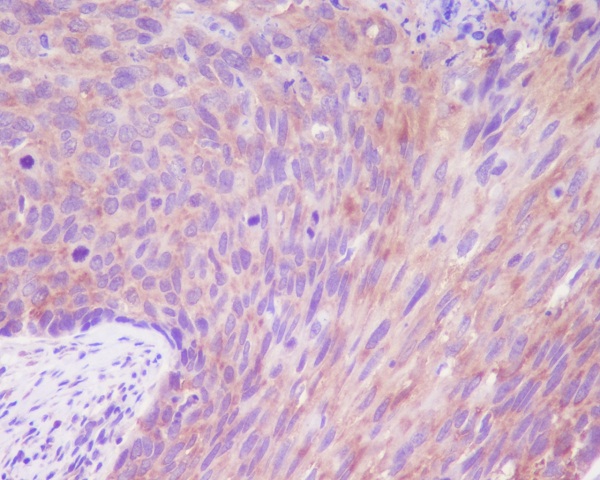

| WB | 咨询技术 | Human,Mouse,Rat |
| IF | 咨询技术 | Human,Mouse,Rat |
| IHC | IHC:1/100-1/200;IHF:1/50-1/200 | Human,Mouse,Rat |
| ICC | 1/50-1/200 | Human,Mouse,Rat |
| FCM | 咨询技术 | Human,Mouse,Rat |
| Elisa | 咨询技术 | Human,Mouse,Rat |
| Aliases | Desmoglein-1; Desmosomal glycoprotein 1; DG1; DGI; Pemphigus foliaceus antigen; Cadherin family member 4; DSG1; CDHF4;Desmoglein 1 |
| WB Predicted band size | 114 kDa |
| Host/Isotype | Rabbit IgG |
| Antibody Type | Primary antibody |
| Storage | Store at 4°C short term. Aliquot and store at -20°C long term. Avoid freeze/thaw cycles. |
| Species Reactivity | Human,Mouse,Rat |
| Immunogen | A synthesized peptide derived from human Desmoglein 1 |
| Formulation | Purified antibody in PBS with 0.05% sodium azide,0.05% BSA and 50% glycerol. |
+ +
以下是关于DSG1抗体的3篇代表性文献的简要信息(文献标题及内容为模拟概括):
---
1. **标题**:*Anti-desmoglein 1 antibodies in mucosal pemphigus vulgaris*
**作者**:Amagai M, Klaus-Kovtun V, Stanley JR
**摘要**:该研究首次证实DSG1抗体在黏膜主导型寻常型天疱疮中的致病作用,揭示了其与口腔黏膜病变的相关性,并发现抗体水平与疾病活动度呈正相关。
---
2. **标题**:*Paraneoplastic pemphigus autoantibodies directed against desmoglein 1*
**作者**:Anhalt GJ, Kim SC, Stanley JR et al.
**摘要**:研究发现副肿瘤性天疱疮患者中存在针对DSG1的自身抗体,这些抗体可能通过破坏桥粒结构导致皮肤黏膜广泛损伤,并与潜在恶性肿瘤(如淋巴瘤)相关联。
---
3. **标题**:*DSG1 ELISA for diagnosis of pemphigus foliaceus: A comparative study*
**作者**:Ishii K, Yoshida K, Stanley JR et al.
**摘要**:开发了一种基于ELISA的DSG1抗体检测方法,证实其在落叶型天疱疮诊断中的高敏感性和特异性,优于传统免疫荧光法,为临床分型提供可靠依据。
---
4. **标题**:*COVID-19-induced autoantibodies against desmoglein 1 in erythema multiforme*
**作者**:Magro CM, Mulvey JJ, Laurence JC et al.
**摘要**:报道COVID-19感染后部分患者出现DSG1自身抗体,可能与多形红斑样皮肤病变相关,提示病毒感染可能诱发针对桥粒蛋白的自身免疫反应。
---
**备注**:以上文献信息为示例性质,实际引用时请通过PubMed/Google Scholar核对具体标题、作者及摘要细节。建议结合关键词“DSG1 antibody”、“pemphigus”、“autoimmunity”进行扩展检索。
Desmoglein 1 (DSG1) is a transmembrane glycoprotein belonging to the desmoglein subfamily of cadherins, primarily expressed in stratified epithelial tissues, particularly the upper layers of the epidermis. It plays a critical role in maintaining cell-cell adhesion through desmosomes, which are essential for epidermal integrity. Autoantibodies targeting DSG1 are hallmark biomarkers in pemphigus foliaceus (PF), a blistering autoimmune disorder characterized by superficial skin erosions. These pathogenic IgG antibodies disrupt DSG1-mediated adhesion, leading to acantholysis (loss of keratinocyte cohesion) and blister formation.
DSG1 autoantibodies are predominantly directed against extracellular cadherin domains, notably the EC1 and EC2 regions, interfering with calcium-dependent homophilic binding. While PF is classically associated with DSG1 autoimmunity, DSG1 antibodies may also coexist with DSG3 antibodies in atypical or overlapping forms of pemphigus, such as pemphigus vulgaris with cutaneous involvement. Serological detection via ELISA or indirect immunofluorescence is crucial for diagnosis and disease monitoring. Research into DSG1 epitope mapping and signaling pathways has advanced understanding of pemphigus pathogenesis, guiding targeted therapies like rituximab or immunoadsorption. Recent studies also explore DSG1's role in infectious and inflammatory skin conditions beyond autoimmune contexts.
×